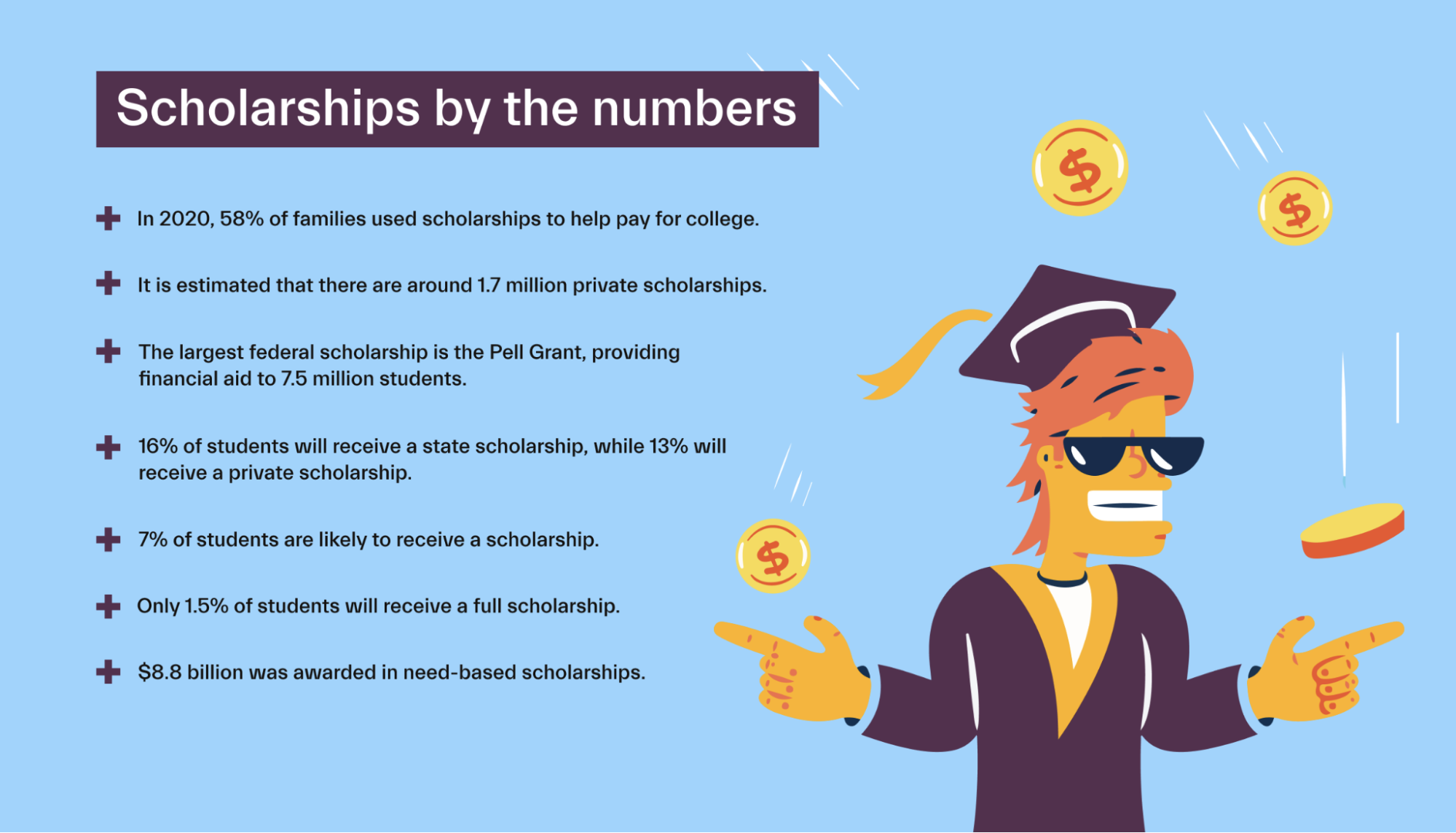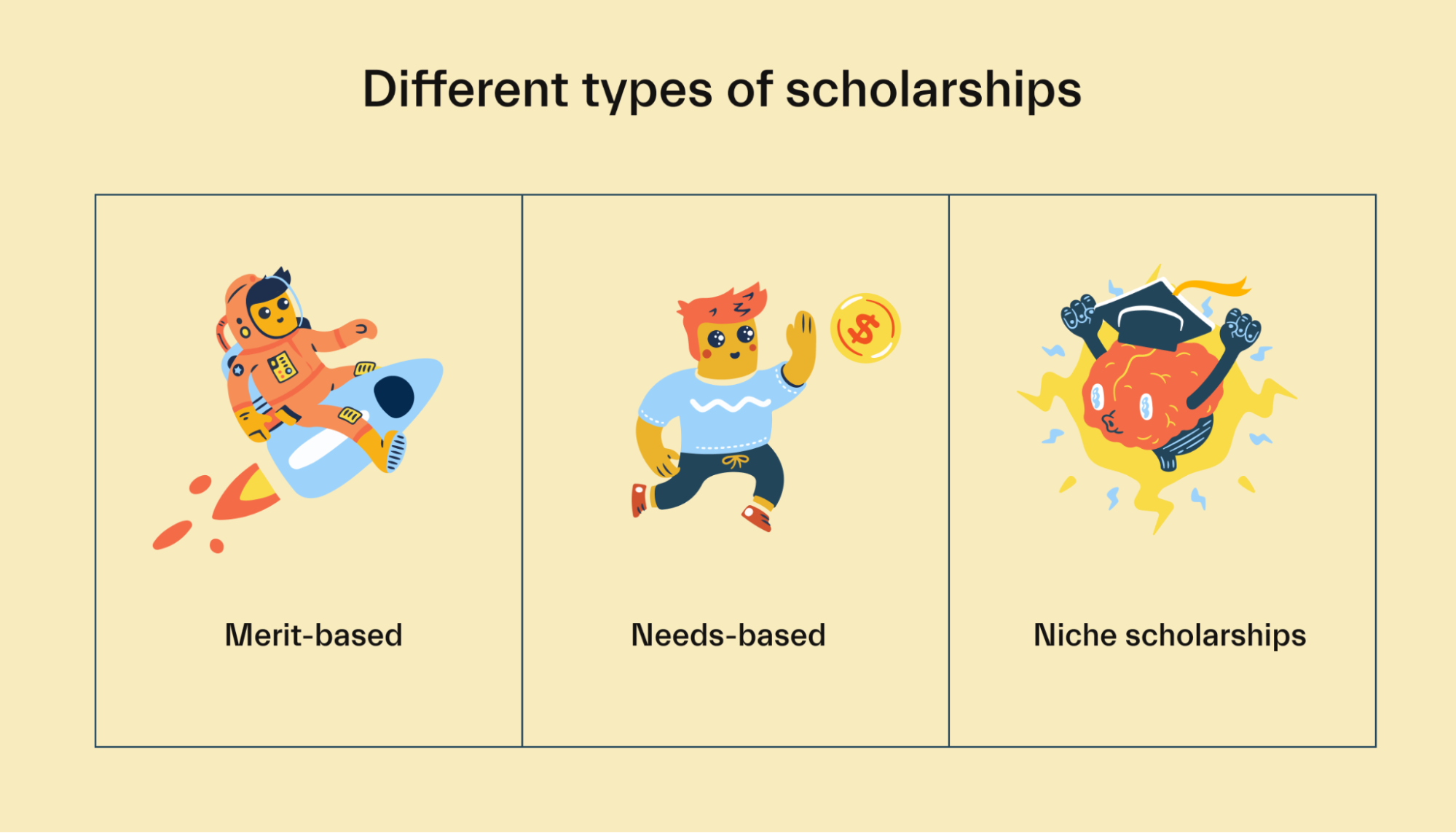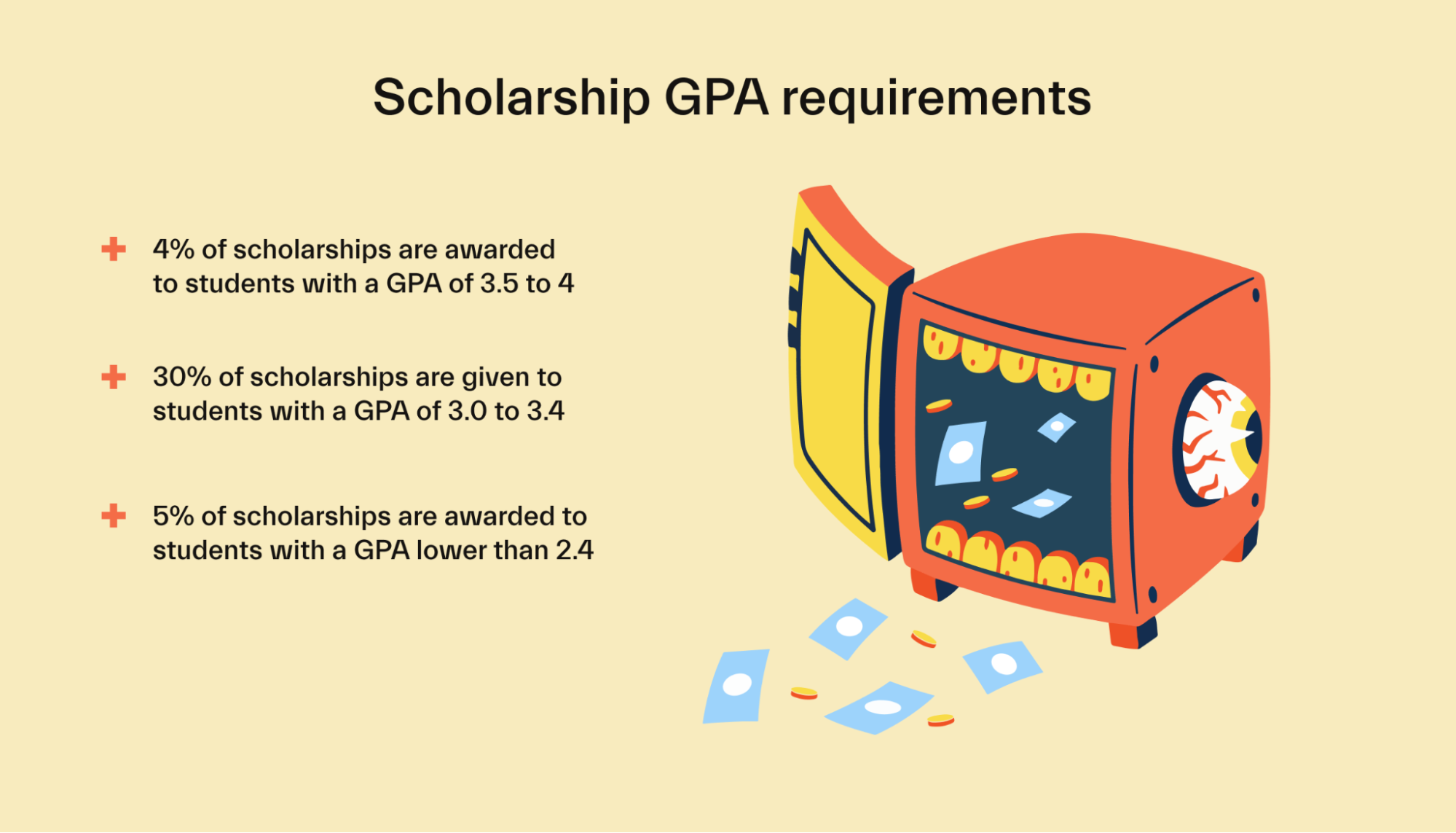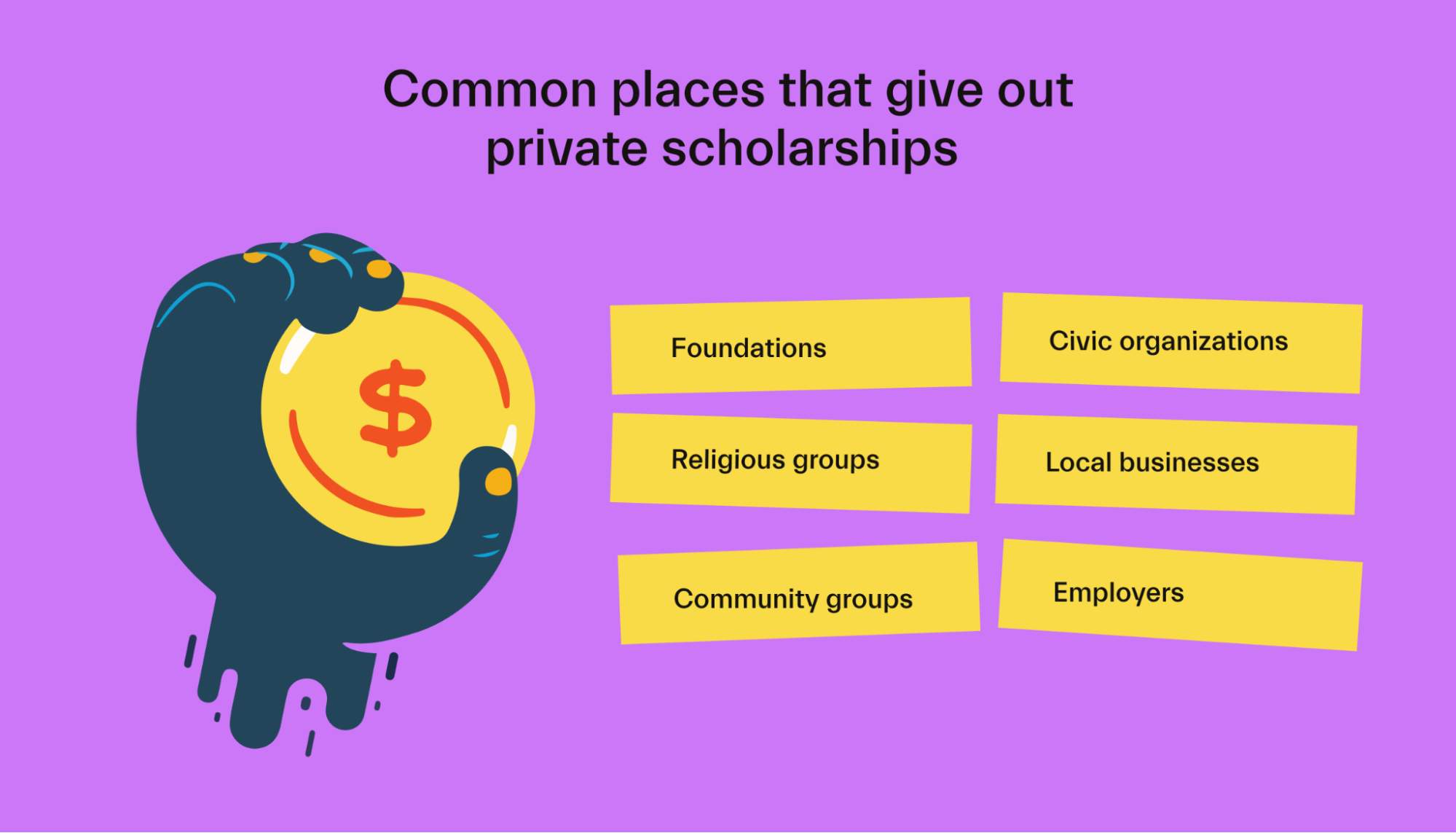Scholarships •
January 27, 2023
How to get a scholarship: a complete guide
Our guide on how to find, apply for, and win a scholarship to help pay for your college education.

For a lot of students, finding enough money to pay for college feels impossible.
After all, tuition just gets more expensive every year—and most of us don’t have thousands and thousands of dollars sitting in the bank.
That’s where scholarships come in!
Scholarships are essentially free money that schools, government organizations, charities, companies, and loads of other groups offer to students to help them pay for college.
There are around 1.7 million scholarships out there, and they’re all designed for different types of students.
In this guide, we’ll explain how scholarships work, how to find a scholarship you qualify for, how to apply for a scholarship, and more.
How do scholarships work?
Before we speed right on to how to get a scholarship, let’s pump the brakes for a second and talk about how scholarships actually work.
Simply put, a scholarship is a financial gift awarded for educational purposes that you don’t need to pay back. Translation: a scholarship is free money to help students pay for college!
With the way college costs keep going up every year, students and their families are more and more reliant on that free money, too. In 2020, a whopping 58% of American families reported using 1 or more scholarships to pay for college.
Fortunately, those families were fairly spoiled for choice.
There are currently around 1.7 million private scholarships on offer from schools, employers, private companies, charities, nonprofits, communities, social organizations, religious groups, individuals, and more.
There are also a number of financial aid opportunities available from the US government—but we’ll get to that shortly.
Tally all of those scholarships up together, and we’re talking about a joint $8.8 billion worth of free college money!

It’s important to note that a single scholarship won’t typically cover the entire cost of your tuition. Many are one-time awards of just a few thousand dollars.
But, every scholarship is worth applying for because it’ll help reduce the cost of your higher education. You can even combine multiple scholarships alongside other sources of financial aid such as grants and loans.
What are the different types of scholarships?
There’s a wide range of scholarships out there, but you can usually group them into 1 of 3 categories: merit-based scholarships, need-based scholarships, and niche scholarships.

Merit-based scholarships are offered to students that meet or exceed certain standards. Those standards are typically based on academic achievement.
For example, a university might sponsor a one-off $5,000 scholarship for all incoming freshman students that earned a score of 30 or more on their ACTs.
But merit-based scholarships can also be based on a special talent, trait, or interest. For example, a regional orchestra could provide an annual scholarship to help send an exceptional violin student to a music college.
Next, there are scholarships that are based on a student’s or family’s financial needs.
These are often called need-based scholarships. Colleges or organizations will generally offer need-based scholarships by asking for information about your financial situation, your family’s income, and your background.
If you qualify, the organization or bursar’s office will offer you a need-based scholarship based on the information you’ve provided. Sometimes the offer amounts vary based on your level of financial need and your family’s perceived ability to pay for your college education.
Finally, there are niche scholarships.
Niche scholarships are financial awards that are designed to help out particular groups of people—and some are more niche than others.
The key is to look at each scholarship’s eligibility requirements.
Some scholarships are open to a fairly broad group of people. For example, you might find a scholarship program online that’s open to all students applying to a college or a university in Maryland.
But many others hone in on particular traits or interests that don’t cater to as big an audience.
For example, there are scholarships out there designed specifically for male nursing students, single mothers, vegetarians, children of military veterans, or aspiring horror novel writers.
Generally speaking, the more niche a scholarship is, the better your chances are of securing the award—as long as you fulfill all of the eligibility requirements.
What qualifies you for a scholarship?
When it comes to eligibility requirements, every scholarship is different. The basic requirements that scholarships providers want to see in their applicants can vary pretty dramatically from program to program.
But in order to give you a rough idea, we’ll quickly break down a few of the most common types of qualifiers that scholarship providers are looking for when they’re sifting through scholarship applications.
The key eligibility requirements usually center on either: academic performance, background or financial need, your interests or major, or a combination of criteria.
Let’s break these down.
Academic performance
A whole lot of the merit scholarships that you’re going to see being advertised and awarded by schools and organizations are based on a number of academic indicators.
A merit-based scholarship might be asking for a minimum score on a standardized test like the ACT or the SAT.
You might also be asked about your academic performance in high school, including your grade point average (GPA) or how much time you devoted to a particular field of study.
For example, you might see a scholarship open to high school students that have been studying the French language for at least 4 years.
You may also find an academic scholarship on offer from a college that's based on your future academic performance. For example, the AnBryce Scholarship at NYU requires students to maintain a minimum GPA of 3.5 after starting school in order to keep the scholarship.
Likewise, the University Freshman Scholarship at Florida State requires you to maintain a GPA of 3.0 throughout your time at college if you want to keep earning scholarship money throughout your 4 years as an on-campus undergraduate.
Translation: when it comes to academic scholarships, GPA and test score performance are pretty important.
That being said, it’s important to bear in mind that each scholarship has its own academic requirements (if it has any at all)—and regardless of what your test scores look like, there will always be options available to you.
In an average year, 4% of scholarships tend to get awarded to students with a GPA between 3.5–4.0. Meanwhile, 30% of scholarships go to those with a GPA of 3.0–3.4. Even 5% of scholarships end up going to those with a GPA of under 2.4!

Likewise, 2/3 of students with above-average SAT or ACT test scores get offered private scholarships—which suggests the remaining 1/3 of scholarships go to students who didn’t necessarily ace their college entrance exams.
Background or financial need
A large proportion of scholarships are awarded based on your or your family’s financial needs. Again, these are generally called need-based scholarships—and applying for them can be pretty simple.
When applying for college, you should make sure to fill out the Free Application for Federal Student Aid (FAFSA).

Both the federal government and your college or university will use the information you’ve provided to assess how much you or your family can realistically afford to contribute to your education.
You’ll generally be asked about the income of your parents or guardians, any part-time work you do, scholarships or grants you’ve already secured, or any investments that have been made in your name, like a 529 college savings plan, Coverdell ESA, or UGMA custodial account.
All of this information will impact your perceived ability to pay for school—and after this assessment, you may get offered a need-based scholarship as a way to help you bridge the gap between the cost of your college tuition and what you’re actually in a position to pay.
Similarly, there’s a wide range of scholarships available designed specifically to support individuals that are applying to college from particular communities.
A school might award a scholarship specifically to a student who is the first person in their family ever to get accepted into college.
Others might award a scholarship to students whose parents have served in the military or to someone who’s grown up in a high-deprivation area in a certain city or neighborhood.
For example, the Albert Shanker College Scholarship is available only to New York City residents from low-income families.
You’ll also see a lot of scholarships that are reserved exclusively for students that represent a minority group.
For example, the NAACP offers more than $800,000 in annual scholarships for high school students or existing college students who are Black.
Similarly, the National Hispanic Medical Association (NHMA) offers a number of scholarships specifically for Hispanic undergraduate nursing students.
Interests or major
You’re also going to see many scholarships created to support students with particular interests or career focuses.
For example, you might find a scholarship specifically for current veterinary students or for students with an extracurricular interest in playing the saxophone.
These slightly more niche scholarships are often awarded by particular schools or institutes within a wider university or by external organizations keen on promoting their special interests by supporting like-minded young people.
For example, the American Board of Funeral Service Education offers scholarships for students working toward a qualification in funeral or mortuary sciences.
Likewise, the CME Group awards scholarships every year specifically to students who are working toward or planning on pursuing a career in the beef industry.
At this point, you probably get the idea.
It doesn’t matter who you are, where you come from, or how much money you’ve got in the bank—if you want to go to college, chances are there are scholarships for you! You’ve just got to do some digging and sniff them out.
How to find scholarships
Scholarships are everywhere. The trick is finding them—and schools and organizations don’t always make that job easy.
There are loads of companies and groups that offer scholarships. But sometimes, those scholarships are only listed on one webpage, a single social media post, or completely offline. That’s why it pays to do your homework and dig deep.
When you’re hunting for scholarships, your first port of call should be the financial aid office at your college, university, or career school. They’ll be able to outline all of the scholarship opportunities available at the school itself.
Colleges will also often catalog and share scholarships on offer from external organizations.
If you’re currently undecided on which college you’re going to, it’s also worth chatting with your high school counselor or TRIO counselor.
Not familiar with TRIO? The federal TRIO programs are national outreach programs that work to identify and support individuals from disadvantaged backgrounds.
If you’re a part of a TRIO program, your counselor should be able to advise you on multiple need-based or background-focused scholarship programs you can apply for.
Federal agencies in general are good sources to learn more about national scholarships—as are state grant agencies and state organizations.
You can also check out the websites of any number of foundations, religious groups, community groups, civic organizations, or local businesses. Many employers also offer scholarships to employees or the children of current employees.

But please be careful.
There are a lot of scholarship scams out there, so you need to make sure you research what you find.
When you find a scholarship that sounds too good to be true, make sure what you’re reading is legitimate. Get in touch with the organization to learn more, and don’t be scared to ask your counselor or school’s financial office about the award.
There are many scholarship sources out there and a lot of scammers, too. You may find you can save a whole lot of time, hassle, and anxiety by getting some professional help sifting through that sea of scholarships to match you with the right opportunities—and that’s where Mos comes in.
With Mos, you get access to the largest scholarship pool in America with Mos, and you can even get help from a personal advisor to navigate you through the scholarship process. An advisor can dig through all the opportunities out there and filter out the scholarship scams to make sure you aren’t wasting any of your time.
Not only does that make you aware of what’s available to you and what you qualify for, but it’ll help you maximize your chances of scoring enough free money to put a major dent in your college expenses.
How to apply for scholarships
Just like eligibility requirements, each scholarship will tend to have its own application processes or requirements.
When you find a scholarship that you’d like to apply for, the scholarship’s website should help you get an idea of when and how to apply.
Just do yourself a favor and make sure you read through the individual processes carefully. If you forget a step, it could end up costing you thousands of dollars.
Again, this is where Mos can really help you out. By taking a short quiz, you can instantly find out whether you’re eligible for a scholarship—then just follow a few simple instructions on how to apply for a particular scholarship.

Many schools will also award you scholarships based on the information you include in your Free Application for Federal Student Aid (FAFSA).
The FAFSA is the US Department of Education’s one-stop application form that lets students apply for loads of different federal grant aid opportunities, work-study, or federal loans.
The information on your FAFSA will normally get passed on to your new school’s finance office—so if the college offers need-based scholarships, you can apply for those by completing your FAFSA.
One of the most important elements of scholarship applications is the deadline. If you want to land free money to pay for college, you absolutely must stay on top of all your deadlines.
A lot of scholarship deadlines pop up a year before you’re even planning to start your freshman year in college. That means if you’re currently in high school, you should think about starting to research and apply for scholarships in your junior and senior years.
That being said, there are also scholarships out there with open-ended deadlines.
Just make sure you stay organized, cross your Ts, and dot your Is. You can’t afford to make any mistakes at the application stage.
Conclusion
If you’re eligible for a scholarship, you owe it to yourself to apply. After all, a scholarship might not cover the entire cost of your college tuition—but every little bit helps.
If you can score a few different scholarships, they start to add up pretty quickly.
Best of all, scholarships are everywhere. There are literally millions of them out there, and there are scholarships designed for people of all backgrounds, interests, financial means, and more.
The tricky bit is just finding them and understanding how and where to apply.
But don’t stress—that’s what we do best. Here at Mos, we’re experts at sifting through all the financial aid opportunities out there to find the scholarships and grants designed specifically for somebody like you.
Are you ready to start getting matched with scholarships? Join Mos now.
Let's get
your money
- Get paired with a financial aid expert
- Get more money for school
- Get more time to do you








